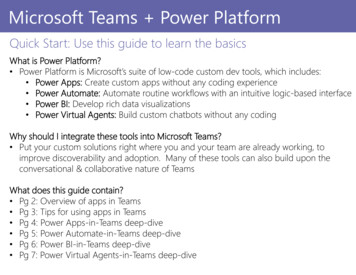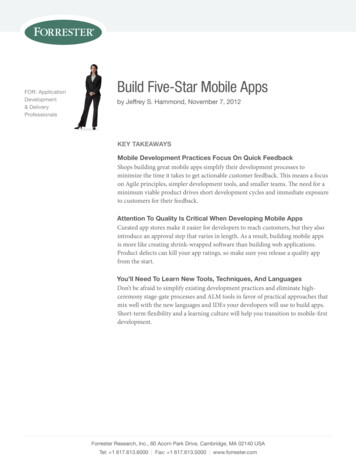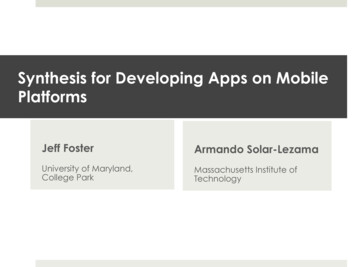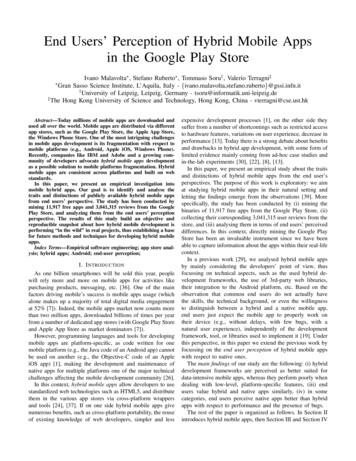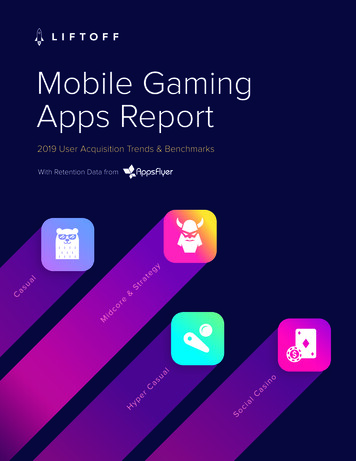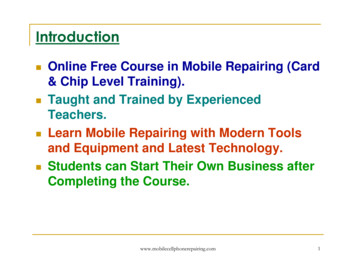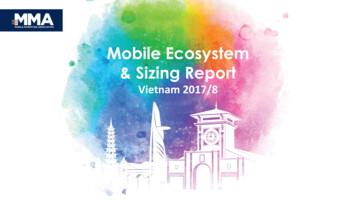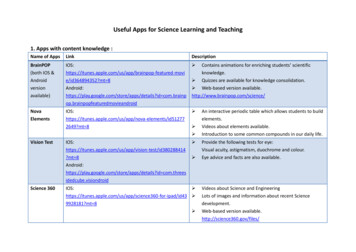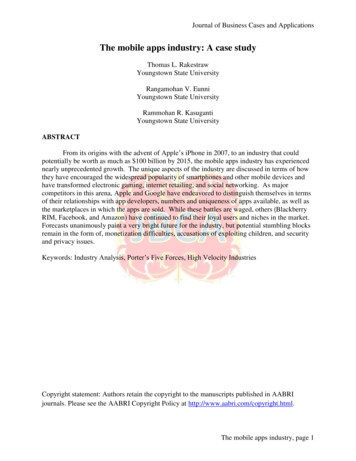
Transcription
Journal of Business Cases and ApplicationsThe mobile apps industry: A case studyThomas L. RakestrawYoungstown State UniversityRangamohan V. EunniYoungstown State UniversityRammohan R. KasugantiYoungstown State UniversityABSTRACTFrom its origins with the advent of Apple’s iPhone in 2007, to an industry that couldpotentially be worth as much as 100 billion by 2015, the mobile apps industry has experiencednearly unprecedented growth. The unique aspects of the industry are discussed in terms of howthey have encouraged the widespread popularity of smartphones and other mobile devices andhave transformed electronic gaming, internet retailing, and social networking. As majorcompetitors in this arena, Apple and Google have endeavored to distinguish themselves in termsof their relationships with app developers, numbers and uniqueness of apps available, as well asthe marketplaces in which the apps are sold. While these battles are waged, others (BlackberryRIM, Facebook, and Amazon) have continued to find their loyal users and niches in the market.Forecasts unanimously paint a very bright future for the industry, but potential stumbling blocksremain in the form of, monetization difficulties, accusations of exploiting children, and securityand privacy issues.Keywords: Industry Analysis, Porter’s Five Forces, High Velocity IndustriesCopyright statement: Authors retain the copyright to the manuscripts published in AABRIjournals. Please see the AABRI Copyright Policy at http://www.aabri.com/copyright.html.The mobile apps industry, page 1
Journal of Business Cases and ApplicationsEVOLUTION OF THE INDUSTRYSince the advent of the iPhone in early 2007, users could experience the functionality ofpersonal computers on pocket-sized devices. These so-called “smartphones” and their associatedmobile software “applications” or “apps” are becoming increasingly ubiquitous in our daily life.According to Mobilewalla.com, a website dedicated to cataloging and rating apps, the onemillionth app was made available to users in December, 2011. Even with many of these appsbeing duplicates, or slight variations created for different devices (e.g., an app created for theiPhone and the iPad would be counted twice), that is an incredible explosion of interest for sucha new industry. The growth in mobile apps has shown no signs of slowing, with as many as15,000 new apps being released each week (Frierman, 2011).The proliferation of apps being developed can only be expected to continue assmartphone usage grows globally. In a 2011 study conducted jointly by Google and IpsosMediaCT Germany, data were obtained via random telephone interviews from amongst thegeneral populations of the United States, United Kingdom, Germany, France, and Japan. Thehighest reported smartphone ownership was found in the United Kingdom (45% of thoseinterviewed) and the United States (38% of those interviewed). Even more telling is the 50%increase in ownership that occurred in the United Kingdom between the first phase of theresearch conducted in January and February of 2011 and the latter phase in September andOctober of that year (The Mobile Movement, 2011). There is clearly a shift in usage fromcomputers to mobile devices.In 2010, smartphones outsold personal computers, which caused tech analysts to shifttheir attention to the handheld platform. During the fourth quarter of 2010, 100.9 millionsmartphones were shipped worldwide, whereas only 53.9 million units had been shipped in thecorresponding quarter of 2009. According to Flurry, a company that collects mobile-softwaredata and provides consulting services to software developers, in 2011, smartphone and tabletshipments exceeded the shipments of desktop and notebook computers combined. Softwaredevelopers are increasingly realizing that in the near future smartphones could replace many corefunctions of personal computers, such as e-mailing, instant messaging, web browsing, and evengaming (Smartphone Mobile Applications To Overtake Standard Websites in Near Future,2012). Further, in comparing publically available data pertaining to Internet usage with their ownclient data concerning mobile app usage, Flurry concluded that users are spending more time onmobile apps than on the Internet, as indicated in Table 1 (Appendix)(Newark-French, 2011).Evidence also suggests that these devices are becoming more and more important inpeople’s lives. In another study conducted by Google in partnership with Ipsos OTX MediaCT,5,013 adults in the United States who identified themselves as using a smartphone to access theInternet were interviewed in the last quarter of 2010. Eighty-nine percent of those interviewedreported using their smartphones throughout the day and 68% reported having used an app in theprevious week. Seventy-nine percent of respondents reported using their smartphones to helpwith shopping, and 22% reported using apps on their smartphones to make purchases (TheMobile Movement, 2011).The continued importance of smartphones and mobile apps was highlighted in PresidentObama’s order that all major federal agencies make at least two public services available onmobile phones by May 2013. The intention of the president’s order was to encourage innovationand stimulate employment in the field of mobile communications. Others have expressed hopethat this initiative would lead to the U.S. government making information available to outsideThe mobile apps industry, page 2
Journal of Business Cases and Applicationsdevelopers that would facilitate the creation of applications to take full advantage of availablegovernment data. It is also anticipated that the increased demand created by those availingthemselves of these governmental services would create pressure on the government to free upbandwidth for use by mobile carriers. In sum, President Obama’s efforts will greatly add to thegroundswell behind the burgeoning field of mobile apps (Melvin, 2012).BASICS OF THE MOBILE APPS INDUSTRYAlthough the mobile apps industry began with Apple’s introduction of the iPhone, itsphenomenal growth is due to the entry of several competitors into the marketplace, notablyMotorola, LG, and Samsung. This competition has given rise to an entirely new product spaceknown as smartphones. Smartphones have far greater functionality than normal mobile phonesdue to their ability to run mobile apps. These applications confer on smartphones the capabilitiesto send and receive e-mail, play music, movies, and video games, and even communicateremotely with computers from virtually anywhere in the world (Coustan & Strickland, n.d.).Smartphones contain many of the same components as personal computers. Everysmartphone has a processor, random access memory stick(s), USB ports, display adapters, andinternal storage devices. Users may even customize and upgrade their devices to suit theirindividual needs. For example, a user who wishes to use the smartphone for gaming canpurchase a device with a multi-core processor and additional storage to hold large games. Mostsmartphones are also equipped with a touchscreen obviating the need for a physical key board.USB peripherals such as audio headphones and data transfer cables are also available forsmartphones (Coustan & Strickland, n.d.).The core software found in a smartphone is called the operating system. The operatingsystem contains all the drivers necessary to carry out instructions between the software andhardware of the device. The operating system can be visualized as a software stack consisting ofseveral layers. First, the kernel manages the drivers that manipulate a smartphone's hardware,such as its built-in camera or USB ports. Middleware contains software libraries which link tomobile applications. The application execution environment contains all the applicationprogramming interfaces (APIs) for developers to program new mobile applications for theoperating system. Finally, the application suite contains core applications which are packagedwith the operating system by default. These applications include phone call software, textmessaging, menu screens, calendars, and more. A mobile app is software that a user can installon a smartphone to perform a particular task. For example, Android has a GPS app which allowsthe user to obtain travel directions in real time, or even track the locations of family membersfrom anywhere in the country (Coustan & Strickland, n.d.).IMPACT ON MOBILE GAMINGBefore the dawn of smartphones, mobile gaming for most users occurred on handhelddevices such as a Nintendo DS or Sony PSP. Now that smartphones have become commonplaceand literally hundreds of low priced games with high-quality graphics are available, mobilegaming has become very different. Apple’s iOS and Google’s open-source Android operatingsystems are capable of running some of the most innovative games in the market. As a resultNintendo's and Sony's handheld devices are quickly losing ground to smartphones (iOS andAndroid Take Over Mobile Gaming Industry, 2011). In 2009, the Nintendo DS accounted forThe mobile apps industry, page 3
Journal of Business Cases and Applications70% of revenue generated by portable gaming software in the United States, with the iOS andAndroid at 19% and the Sony PSP at 11%. In 2010, the Nintendo DS dropped to 57% of therevenues while iOS and Android picked up 34%. By 2011, the Nintendo DS fell to 36% whileiOS and Android claimed 58% of the revenues from portable gaming software. In 2009, the iOSand Android revenues from mobile gaming stood at 500 million. By 2010, these revenuesspiked to 800 million, and continued to climb in 2011 when they hit 1.9 billion, demonstratingthe speed with which mobile apps are revolutionizing the use of digital media and tools (iOS andAndroid Take Over Mobile Gaming Industry, 2011).IMPACT ON TRADITIONAL WEBSITESMany now believe that apps will eventually supplant standard Internet websites in theway that DVRs have replaced videotaping and cell phones replaced land line phones. Advancesin technology have enabled web developers to not only program for standard web browsing butfor mobile browsing as well. This trend of mobile apps taking the place of traditional websites islikely to accelerate for a number of reasons. First, a mobile application can be accessed fromvirtually anywhere without the need for a wireless hotspot or expensive and physically largepiece of hardware. Additionally, many companies and other website owners have created mobileversions of their websites to provide faster loading times, and have optimized user interfaces andother features to add to the functionality of mobile browsers. Not surprisingly, as of 2011 thenumber of users accessing websites from their mobile phones exceeded those who did so frompersonal computers (Smartphone Mobile Applications To Overtake Standard Websites in NearFuture, 2012).NATIVE APPS VS. MOBILE WEB APPSThere are two main types of mobile applications: native and mobile Web. Nativeapplications integrate directly with the mobile device's operating system and can interact with itshardware much like the software on a personal computer. Native applications are also capable oftaking advantage of local APIs in order to maximize functionality while preserving efficiency.Mobile Web applications are apps that run directly from an online interface such as a website.These applications typically cannot manipulate a device's hardware and are limited to the webapplication's APIs rather than the programming packages found on the phone (IndustryInnovations: A Mobile Applications Interview with Bob Evans, 2011). A mobile website is aseries of web pages created for the sole purpose of being viewed on a mobile device's webbrowser. These pages are often created using HTML, but some operating systems such as iOS orAndroid are equipped with a webkit. These webkits enable web page rendering that extendsfunctionality far beyond that of a typical mobile Web application; they allow hardwaremanipulation, user interface scaling, and more (Industry Innovations: A Mobile ApplicationsInterview with Bob Evans, 2011).Some applications are hybrids that combine the interface and coding components of aweb-based interface with the functionality derived from native applications. This allowsdevelopers to update the application remotely while still affording a large amount ofprogramming functionality. It also extends the number of platforms which can run theapplication, as their web-based nature ensures the application must not necessarily be platformspecific (Industry Innovations: A Mobile Applications Interview with Bob Evans, 2011).The mobile apps industry, page 4
Journal of Business Cases and ApplicationsCurrently, the two dominant operating systems - Google’s Linux-based open-source AndroidOperating System and Apple's iPhone Operating System (iOS) - both support their ownmarketplaces where users can purchase mobile applications. Some apps are packaged with theoperating system by default, but most apps must be downloaded manually from an appmarketplace (Coustan & Strickland, n.d.).THE MARKETPLACE: APPLE VS. GOOGLEA mobile application marketplace is software which allows the user to download ordistribute mobile apps for their smartphone. Free applications may be found in thesemarketplaces alongside those offered for sale. In most cases, apps are programmed by third partydevelopers such as companies hoping to advertise or enhance their existing products, or byfreelance programmers who sell their apps for revenue. Both the leading operating systems,Apple and Android, each have a corresponding dedicated marketplace, as indicated in Tables2(a) and 2(b) (Appendix). However, third party marketplaces also exist which may offer thesame apps, often at different price and/or apps that are unique to that site (Coustan & Strickland,n.d.).Two types of independent app stores exist for developers to publish their apps: a) fullcatalog stores, which sell applications for multiple operating systems and are typically associatedwith higher priced apps, and b) platform specialists, which are niche marketplaces thatconcentrate on only one operating system. These marketplaces tend to be more user-friendly andfocus on a community-driven, socially-structured interface which give customers the opportunityto compare prices between multiple, similar applications to find the best in price and quality.Full-catalog stores tend to distribute apps at higher prices on an average than those found inplatform specialist stores. The prices users are willing to pay for apps appear to depend upon themarketplace. For example, Handango, a full-catalog app store, has an average app price of 9.10.On the other hand, the Amazon App Store, which is a specialist Android marketplace, has anaverage app price of only 2.52 (Mikalajunaite, 2011).Restrictive policies of Apple concerning app development in the initial phase have had ademonstrable effect on the market for iOS apps. In mid-2010, a survey revealed that 54% of allmobile app developers prefer to develop apps for the Android operating system while only 40%prefer to do so for Apple’s iOS. Later that year, Google and Apple made several announcementsregarding the future of their mobile operating systems, and Google was the clear winner. Asubsequent survey revealed that 58.6% of these developers now preferred Android while thesupport for the iOS dropped to 34.9% (Cameron, 2010). In response to these findings, Appleeased some of the restrictions placed on iOS developers and publishers with a view to make theirplatform somewhat more open. Apple also released additional documentation to the publicregarding the process by which applications are accepted for sale in the iOS app store. However,these changes apparently had little impact on the confidence mobile developers placed in thecompany's operating system. Significantly, 62% of the developers surveyed revealed theirpreference to develop for Android-powered devices as compared to only 58% for the iPad beforeits launch. With Google reaping a higher level of support from mobile developers across theboard, Apple may face difficulty in gaining new apps to distribute in their mobile app store(Cameron, 2010).Google, however, is not without concerns of its own. Amazon's new applicationmarketplace decentralizes users’ acquisitions of mobile apps. Users visiting multiple app storesThe mobile apps industry, page 5
Journal of Business Cases and Applicationsto compare prices and find exclusive apps may become an unwieldy experience and detract fromthe level of convenience that Android has worked so hard to attain. However, on the upside,Amazon’s entrance into the Android market may bring in additional users, and ultimately bodewell for the future of this operating system (What Developers Should Know About Amazon'sAndroid App Store, 2010).THE AMAZON MARKETPLACEOnline retail giant Amazon has developed a specialized marketplace to distribute mobileapplications for the Android platform and serve as the main interface for Amazon’s Kindle Firewhich runs a restricted version of the Android OS. This marketplace was created to provide amore organized, intuitive, and user-friendly alternative to the standard Android Market and isavailable for all Android users (What Developers Should Know About Amazon's Android AppStore, 2010).Like other mobile application marketplaces, Amazon splits revenue by payingdevelopers 70% of the purchase price per sale, while retaining 30% of the purchase price forAmazon. However, Amazon requires an annual fee of 99 for publisher participation in thismarketplace compared to Android's one-time 20 fee. In addition, Amazon reserves the right tomodify an application's code and even add its own DRM (Digital Rights Management, a systemto prevent piracy in digital goods such as music and software) to the binary. In contrast to thelargely unrestricted Android Market, Amazon also has a set of rules to which all publishers mustadhere. For instance, applications on the Amazon marketplace cannot be sold at a lower price incompeting marketplaces such as the Android Market. Amazon also reserves the right to modifythe prices of apps without prior approval of the original publishers. Finally, developers mustdeliver any updates to the apps to the Amazon market before doing so in other markets. Forexample, it is illegal to distribute an app update to the Android Market before it is uploaded toAmazon's marketplace (What Developers Should Know About Amazon's Android App Store,2010).THE FACEBOOK MARKETPLACEFacebook working in tandem with one of its major partners, Zynga, has a huge stake inthe future of the mobile apps industry. The success of Zynga’s online gaming apps has benefitedboth the companies immensely. Nineteen percent of Facebook’s 2011 revenue and 15% of its2012 first quarter revenue was tied to Zynga, most of which came from the fees the companyreceived for processing users’ purchases in Zynga’s gaming apps. However, there seems to be aconsensus that the future of both these companies is dependent upon their ability to extend thatsuccess to mobile applications. The growth of online social games has slowed as the growth ofmobile games for iOS and Android devices has exploded (The Most Important Friendship:Facebook and Zynga, n.d.).The need for Facebook to transfer its success to mobile devices may be the greatest inglobal markets into which it hopes to expand. From February to March of 2012, Facebook added56 million users, most of who were based in Asia. They seem to have been particularlysuccessful in gaining mobile users in countries such as Japan. Their efforts there involvedcreating a mobile site that worked on Japanese phones and building relationships with localdevelopers. According to Google data, Japan’s use of smartphones had tripled in less than a year.The mobile apps industry, page 6
Journal of Business Cases and ApplicationsSimilarly, Facebook has added 2.5 million users in the first six months of 2012, accelerating thegrowth that was stimulated by the introduction of the iPhone there in 2010 (Wagstaff, 2012).Facebook’s expansion plans are particularly challenging in India. Many Indians havemobile phones and mobile usage is growing faster than web usage. Furthermore, as China isclosed to them as a market, India represents the largest population of potential new users that isavailable. However, much cellphone service in India is provided over less than 3G quality(slower) networks and the users’ equipment may be antiquated. Facebook has penetrated themarket to the point that 60 percent of the Internet population in India has used the service(representing 51 million users), but given the technological limitations it is extremely difficultfor Facebook to reproduce the “large screen experience” on basic phones (What DevelopersShould Know About Amazon's Android App Store, 2010).Facebook CEO Mark Zuckerberg has stated that improving Facebook’s mobileapplication, integrating it with other online apps, and creating a “transformative” advertisingexperience were top priorities for 2012. Numerous third parties have pointed out that being ableto monetize its presence with mobile users will be essential to its future success. In a publicmeeting with investors in May 2012, Zuckerberg and COO Sheryl Sandberg pointed out that thekey to Facebook’s success on mobile devices would be social ads that make use of informationconcerning the “likes” of users’ friends and that the collection of additional information such asusers’ locations would be key to targeted advertising efforts (Barr, 2012).One means by which Facebook hopes to improve its mobile presence is its new AppCenter. This will be a central location at which users will be able to access all apps (initially,600) that have been reviewed and cleared by Facebook as having met their quality standards.Rather than happening upon apps randomly, users will have apps recommended to them by theApp Center based upon their expressed interests or those of their friends. Links in the AppCenter will send users to the appropriate Apple or Google marketplace from where the appscould be downloaded (Barr, 2012).THE BLACKBERRY ANDROID MARKETPLACEIn early 2011, Research In Motion (RIM) announced its new PlayBook tablet computerthat has the capability to run Android applications using an 'app player'. This device can runBlackBerry Java apps as well; creating a very powerful piece of hardware that is capable ofrunning apps from multiple platforms. All these applications are available through RIM'sBlackBerry App World, which is the company's dedicated marketplace for Android andBlackBerry apps (RIM's New Playbook Will Be Able to Run Android Mobile Applications,2011).However, Android applications which are run on the PlayBook cannot be obtainedanywhere else other than the BlackBerry App World. This implies that apps from othermarketplaces, such as the Android Market and other third-party marketplaces such as theAmazon App Store are not compatible with this device. For Android developers, this means theirapps must be compiled using specific rules, certificates, programming packages and permissionsdesigned to run on RIM’s PlayBook. This adds a new layer of complexity for developers whichcould potentially detract them from programming for the PlayBook. It also means that fewerapps will be available for PlayBook users than for native Android users. In 2011, for example,the Android Market had over 250,000 apps whereas the BlackBerry App World had only 20,000apps (RIM's New Playbook Will Be Able to Run Android Mobile Applications, 2011).The mobile apps industry, page 7
Journal of Business Cases and ApplicationsRIM had also announced the release of a SDK, which would enable applicationprogramming for the PlayBook's operating system, Tablet OS. This will allow low-levelcustomization of the tablet, including its user interface and other functionality that expandsoutside the scope of standard applications. Additionally, Ideaworks Labs and Unity Technologiesare also capable of running on PlayBook. Ideaworks is a C and C SDK for mobile platforms,which runs on iOS, Android, Symbian, webOS, and Windows Mobile. Unity Technologies offersa host of tools used for creating 3D games for iOS and Android, which may add appeal forpotential game developers (RIM's New Playbook Will Be Able to Run Android MobileApplications, 2011).NICHE MARKETPLACESRecently, a number of new third-party marketplaces have entered the mobile appsindustry. Since many of these marketplaces are developed by companies far smaller than Googleor Apple, they have been forced to target niche app user segments rather than engage in full scalecompetition with the bigger players. Since 2009, the number of niche app stores has doubledannually, while the number of general app stores has decreased. The number of general appstores entering the market peaked toward the end of 2010, and declined rapidly through 2011.These data clearly suggest that niche marketplaces are the preferred solution for smallercompanies to penetrate the mobile apps industry (Gair, 2011).Niche marketplaces provide users with applications targeting their specific needs, thusreducing much of the confusion created by the ever-increasing number of developers and apps.These marketplaces could also benefit developers by reducing the number of apps they competewith for attention in full catalog stores. In general, there are three categories of niche mobile appmarketplaces. 1) Platform-oriented marketplaces offer applications for a specific operatingsystem, such as AndroidPIT for Android or Crackberry for RIM devices; 2) Target grouporiented marketplaces that provide apps for a particular segment of app users, such as businessesor adults; and 3) “Carve out” marketplaces, which are niche stores within a full catalog store,such as “@work” by Apple (Gair, 2011).CONSUMER PREFERENCES IN MOBILE APPSBy the year 2010, the mobile apps industry became increasingly saturated as newcompetitors entered the market flooding it with numerous varieties of utilitarian as well aslifestyle apps. A survey conducted by Nielsen in 2010 revealed the types of apps that were ingreatest demand by users. A breakdown of the various categories of applications used within aspan of 30 days as emerging from the survey is presented in Table 3 (Appendix) (The State ofMobile Apps, 2010). In addition, a chart of app popularity by users of specific operating systemsis depicted in Table 4 (Appendix). The survey revealed that games, including both free and paid,were the most downloaded application category. Facebook, Google Maps, and the WeatherChannel were the most popular apps across all platforms. In social networking, Facebook was byfar the most popular app, with MySpace trailing behind in part due to its continuing popularitywith teenagers. LinkedIn also attracted a large number of users in the age group of 25 to 44 (TheState of Mobile Apps, 2010). The news and weather application category was dominated by TheWeather Channel, which was downloaded by 58% of the users surveyed. Amazon and eBay ledthe shopping category with 57% and 41% respectively. Finally, the music category was fiercelyThe mobile apps industry, page 8
Journal of Business Cases and Applicationscompetitive with iTunes, Pandora, Sirius-XM, and Yahoo! Music all competing for the #1position (The State of Mobile Apps, 2010).Data collected by Flurry in May 2011 revealed that games and social networking apps,led by Facebook, continued to be the most popular app categories among users, as indicated inTable 5 (Appendix). Flurry also discovered that users not only accessed game and socialnetworking apps more frequently but also for longer periods of time per session. That many userswere accessing Facebook in order to play games available on that platform points to theoverwhelming dominance of this category of smartphone apps (Newark-French, 2011).In 2010, the most acknowledged choice for app publishers was the iPhone’s iOSoperating system. However, other operating systems like Android, iPad, Windows Mobile andSymbian also enjoyed large spikes in usage as the devices associated with them became morepopular and developers attempted to diversify their products accordingly. A breakdown of themajor mobile operating systems and their utilization by app developers in 2010 is presented inTable 6 (Appendix) (State of the app industry 2010 (report), 2010).In 2011, the emerging operating systems, especially Android and Microsoft’s WindowsPhone 7, were expected to gain in usage. Microsoft has attempted to stimulate developer interestin its platform by offering incentives to programmers to create pre-release applications.Microsoft has also invested considerable resources in marketing its new product, especially byencouraging favorable reports by technology reviewers. A breakdown of the projected appdeveloper support for 2011 is shown in Table 7 (Appendix)(State of the app industry 2010(report), 2010):Finally, a chart showing publishers’ expectations of revenue increases for the mobile appindustry between 2010 and 2011 is presented in Table 8 (Appendix). Clearly, most publisherswere highly optimistic about the industry; with 31% believing revenues would more than double,and 17% predicting revenues would increase by at least 50 (State of the app industry 2010(report), 2010).DEVELOPERS AS COMPLEMENTORS TO THE INDUSTRYIn order for companies like Google and Apple to effectively compete in the mobileapplication industry, they must attract innovative developers to create software for theiroperating systems and devices. Without the support of developers, the inflow of new apps willwane, leading to the customers shifting to more popular systems. Therefore, innovative businessmodels must be put in place by these platform owners to remain attractive to developers andthereby sustain their competitive advantage (Power, n.d.).A successful business mode
Android at 19% and the Sony PSP at 11%. In 2010, the Nintendo DS dropped to 57% of the revenues while iOS and Android picked up 34%. By 2011, the Nintendo DS fell to 36% while iOS and Android claimed 58% of the revenues from portable gaming software. In 2009, the iOS and Android revenues f
